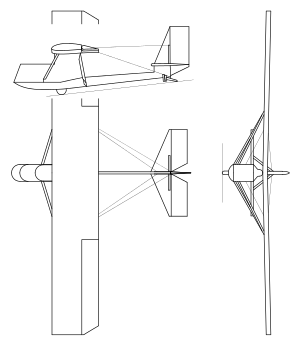Antonov A-1
The Antonov A-1 and related designs were a family of single-seat training gliders produced in the Soviet Union in the 1930s and 1940s. All were derived from the Standard-2 (Стандарт-2) (designed and flown by Oleg Konstantinovich Antonov in 1930[1]), which in turn was derived from the Standard-1.[2] They were produced in large numbers, with around 5,400 built of the U-s3, U-s4 and P-s2 major versions alone.[3] The same design formed the basis for the Antonov A-2 and its related group of two-seat designs. Altogether, including the two-seaters, production exceeded 7,600 by 1937.[4]
| A-1 | |
|---|---|
_(9717448281).jpg) | |
| Role | Training glider |
| National origin | USSR |
| Designer | Oleg Konstantinovich Antonov |
| First flight | 1930 |
| Number built | ca. 5,700 |
While members of the family varied in detail, they shared the same basic design, and parts were interchangeable between them.[1][5] The design featured a typical primary glider layout with a conventional empennage carried at the end of a long boom in place of a conventional fuselage. The boom could be folded sideways for storage.[6] The monoplane wing was carried high on a pylon above this "keel" and was further braced to it with two struts on either side.[7] The pilot sat in front of the wing, and was enclosed in a simple U-shaped wooden fairing that was removed by sliding it forward to allow him or her to enter and leave the aircraft.[8] The undercarriage consisted of a single skid underneath the "keel", but this could also be fitted with small wooden wheels.[9]
While the original primary training versions (designated У, 'U') featured wings of constant chord,[7] subsequent variants designed for soaring flight (designated П, 'P') had longer-span wings with tapering outer panels and a streamlined nose fairing.[10] The ultimate development in the line were gliders intended for towed flight (designated Б, 'B), which shared the longer wings and streamlined fairing of the P-types, but added a canopy to enclose the cockpit.[10]
Unlicensed copies were produced in Turkey following World War II by THK and Makina ve Kimya Endüstrisi Kurumu (MKEK), as the THK-7 (P-s2) and THK-4 (U-s4).[11]
Variants
In each case, the "s" stands for serii (серии: 'series')
Prototypes
- Standard-1 (Стандарт-1)
- Standard-2 (Стандарт-2)
Trainers
Uchebnyi (Учебный, 'Trainer')
Sailplanes
Paritel (Паритель, 'Sailplane'), also Upar (Упар, portmanteau of учебный паритель, uchebnyi paritel, 'training sailplane') (800 built[3])
- P-s1 (П-с1)
- P-s2 (П-с2)
Towed
Buksirovochnye (Буксировочные, 'Towed') (265 built by 1937[4])
- B-s3 (Б-с3)
- B-s4 (Б-с4)
- B-s5 (Б-с5)
Specifications (A-1)

Data from Krasil'shchikov 1991, 230
General characteristics
- Crew: one pilot
- Length: 5.60 m (18 ft 5 in)
- Wingspan: 10.56 m (34 ft 8 in)
- Height: 1.70 m (5 ft 7 in)
- Wing area: 15.6 m2 (168 sq ft)
- Empty weight: 92 kg (200 lb)
- Gross weight: 164 kg (361 lb)
Performance
- Maximum speed: 70 km/h (40 mph, 35 kn)
- Rate of sink: 1.2 m/s (240 ft/min)
Notes
- Sheremetev 1959, 20
- Krasil'shchikov 1991, 145
- Central Museum of the Air Force
- Krasil'shchikov 1991, 143
- Shushurin 1938, 13
- Shushurin 1938, 16
- Sheremetev 1959, 21–22
- Sheremetev 1959, 40
- Sheremetev 1959, 42
- Krasil'shchikov 1991, 146
- Deniz 2004
References
| Wikimedia Commons has media related to Antonov A-1. |
- "Antonov Oleg Konstantinovich". Central Museum of the Air Force website. Retrieved 2008-10-06.
- Deniz, Tuncay (2004). Turkish Aircraft Production. Munich: Levent Başara.
- Krasil'shchikov, Aleksandr Petrovich (1991). Planery SSSR (Gliders of the USSR). Moscow: Moskva Mashinostroyeniye.
- Sheremetev, Boris Nikolayevich (1959). Planery (Gliders). Moscow: DOSAAF.
- Shushurin, V.V. (1938). Atlas konstruktzii planerov (Directory of glider construction). Moscow: Gosudarstvennoe izdatel'stvo oboronnoi promyshlennosti.